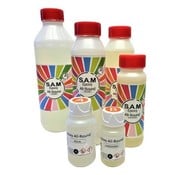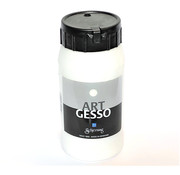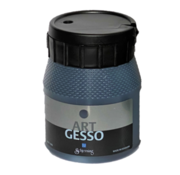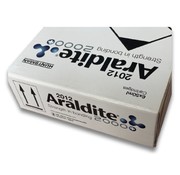Primers, adhesives and related articles
For bonding materials, it is best to work wet in wet. If that is not possible, a primer (wet on dry) or an adhesive (dry on dry) is often necessary.
All-Round Epoxy Casting Resin
€ 10,50 € 8,68 Excl. tax
✔ Very strong and impact resistant
Compare
✔ Clear and highly UV-resistant
✔ Shore D85
✔ Castings 1mm <> 50mm
✔ 20-25 minutes working time
✔ Mixing ratio (Weight) 100: 50Art Gesso White
€ 13,80 € 11,41 Excl. tax
Base coat for painting. Made on acrylic chalk base. Absorbent, lightfast, non-aging, waterproof drying. Drying time 2 hours.
CompareArt Gesso Black
€ 13,80 € 11,41 Excl. tax
Base coat for painting. Made on acrylic chalk base. Absorbent, lightfast, non-aging, waterproof drying. Drying time 2 hours.
CompareSilicone Glue Set
€ 49,19 € 40,65 Excl. tax
✔ Bonding hardened silicone on various surfaces
Compare
✔ 2 components
✔ Easy to use
✔ Fast effectSilicone glue Wacker Elastosil E43 - Food grade
0% Sale
€18,39 € 18,39 € 15,20 Excl. tax
✔ One component acid-based curing system.
Compare
✔ Self-leveling.
✔ Excellent adhesion on various surfaces
✔ Colorless transparent or Black
✔ Good mechanical properties
✔ Heat resistant
✔ Resistant to weather influences and aging
✔ PeSilicone glue Wacker Elastosil E43N - Food grade
€ 34,25 € 28,31 Excl. tax
✔ Food grade
Compare
✔ One component acid-based curing system.
✔ Self-leveling.
✔ Excellent adhesion on various surfaces
✔ Colorless transparent
✔ Good mechanical properties
✔ Heat resistant
✔ Resistant to weather influences and agingSilicone glue Wacker Elastosil E4
€ 33,95 € 28,06 Excl. tax
✔ Acetoxy-curing RTV-1 silicone
Compare
✔Low Shore A hardness
✔ Excellent adhesion without primer on many surfaces
✔ Good heat stability
✔ One component
✔ Immediately ready for use
✔ Also usable for FIPG/ CIPGSilicone glue Wacker Elastosil E41
€ 38,98 € 32,21 Excl. tax
✔ Self-levelling
Compare
✔ Solvent containing
✔ Excellent adhesion on cured silicone rubber
✔ High-tear grade
✔ Recommended service temperature from -45°C to 180°C
✔ Max. recommended short term peak temperature exposure 200°CEpoxy glue Araldite 2012 (50 ml)
€ 198,- € 163,64 Excl. tax
ARALDITE® 2012 adhesive has a long history of creating fast-curing, high performance bonds between multiple materials.
CompareSilicone glue Wacker ELASTOSIL® E10 RED
€ 32,90 € 27,19 Excl. tax
✔ Recommended service temperature from -45 °C to +230 °C
Compare
✔ max. recommended short term peak temperature exposure 250°C
✔ non-thixotropic
✔ Flowable
✔ Heat resistant
✔ Low viscosity
✔ One-component
✔ Solvent-freeSilicone Primer Wacker ELASTOSIL® AUX G 3243
€ 14,51 € 11,99 Excl. tax
✔ Provides excellent adhesion onto various substrates.
Compare
✔ For addition curing silicone
✔ Solvent based
✔ Various application methods (e.g. coating, dipping, brushing, spraying)
✔ Further dilution in organic solvents possibleSilicone glue Wacker ELASTOSIL® A07 TRANSLUCENT
€ 23,59 € 19,50 Excl. tax
✔ready-to-use, one-component system
Compare
✔low module
✔excellent primerless adhesion to many substrates
✔no use of organotin catalysts
✔ Flexible at low (-40 °C) and high temperatures (+180 °C)
✔Flowable
✔Low viscosity
✔Solvent-bas- Pay later with Klarna
- 30 Days return period!
- Advice from real Experts
Silicone adhesive Wacker ELASTOSIL® N2010
-16% Sale
€37,89 € 32,- € 26,45 Excl. tax
✔ Recommended operating temperature from -45 °C to +180 °C
Compare
✔ Neutral curing (Alkoxy), no acid
✔ Sprayable
✔ Good adhesion to many substrates without primer
✔ One component
✔ Solvent free
✔ Self-LevelingSilicone Primer Wacker AV (SLM 74300)
€ 49,06 € 40,55 Excl. tax
✔ low solvent content
Compare
✔ straightforward processing
✔ 2 component mixing ratio 2:1
✔ excellent adhesion
✔ no drying necessarySilicone glue Wacker Elastosil E43 BLACK- Food grade
-13% Sale
€30,50 € 26,50 € 21,90 Excl. tax
✔ One component acid-based curing system.
Compare
✔ Self-leveling.
✔ Excellent adhesion on various surfaces
✔ Colorless transparent or Black
✔ Good mechanical properties
✔ Heat resistant
✔ Resistant to weather influences and aging
✔ PeSiliconen Primer Wacker G791
€ 22,41 € 18,52 Excl. tax
✔ low solvent content
Compare
✔ straightforward processing
✔ 2 component mixing ratio 1:1
✔ excellent adhesion
✔ no drying necessarySiliconen Primer Wacker G795
€ 22,16 € 18,31 Excl. tax
✔ Increases the adhesion between condensation and addition curing silicone and various surfaces
Compare
✔ Functions on metals, wood, various plastics such as PETG
✔ Soluble in white spirit or alcohol
✔ Works with silicones with a high oil contentSiliconen Primer Wacker G790 - toluene free
€ 18,25 € 15,08 Excl. tax
✔ Increases the adhesion between condensation and addition curing silicone and various surfaces
Compare
✔ Used for Arresters, Cable Accessories, Insulators
✔Organic solvent, free of toluene and aromatic solvents

3 Methods to bond
Wet in wet: If two similar products such as silicones or epoxies, polyurethane, etc. have to bond well with each other, it is of course best to work wet in wet. That means the second coat is applied while the first is still runny or at the very least very tacky.
This is used in addition silicone to build up thick layers when silicone is spattered or sprayed instead of poured. With epoxy and PU, it is often done correctly to avoid having to pour a very thick layer or large volume in one go. The resin could then become too hot and shrink considerably, tear, discolour or even burn.
The disadvantage of this technique is that you have to wait until you can continue and that you can often (in the case of clear resins) see a dividing line between the two layers.
Wet on dry: If you want to have a resin or silicone material that has yet to be cured adhere to a cured material, we call this wet on dry bonding. This is no problem for condensation silicone. Condensation silicones always adhere to cured condensation and to addition silicones. Epoxy also works well. It is more difficult with PU and with acrylic resin.
In all cases, it is wise to roughen the surface and degrease it well with isopropanol!
It is often wise to use a primer. For example, when gluing silicone to iron using the G790 primer or PU on a stone substrate with the primer Nevirprim.
Dry on dry: If you want to bond two cured products, you can use a flexible bonding material or a stiff glue.
Silicone caulk is a good way to make silicone bond to silicone. For example the E4, E41 and E43. Silicone sealant is flexible and therefore provides a flexible bending and stretching bond.
You can often also use an ordinary condensation silicone for good adhesion.
The sealant can also be used to bond silicone to a wooden or iron surface (with or without some extra help from a primer).
Silicone sealant can also be used to flexibly bond iron to iron or wood to wood etc.
The flexpox (a flexible epoxy) can also be used to connect materials flexibly.
In addition to flexible sutures, you can also use good cyanoacrylates. These often have to be combined with a primer on silicone and other rubbers to allow the adhesive to bond. This application is very fast and strong. The disadvantage is that it does not give much and the silicone / rubber often hardens at the place of application.





